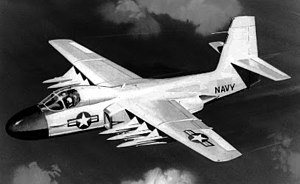Douglas F6D Missileer
| F6D Missileer | |
|---|---|
 |
|
| Artist's conception of the F6D-1 Missileer in flight. | |
| Role | Fleet defense fighter |
| Manufacturer | Douglas Aircraft Company |
| Status | Canceled December 1961 |
| Primary user | United States Navy (intended) |
| Number built | None |
The Douglas F6D Missileer was a proposed carrier-based US Navy fleet defense fighter aircraft, designed by Douglas Aircraft Company in response to a 1959 US Navy requirement. It was designed to be able to loiter for extended periods at a relatively long distance from the Navy's aircraft carriers, engaging hostile aircraft 100 mi (161 km) away with its powerful radar and long-range missiles. Since the enemy would be fired on long before they reached visual range, the aircraft had little dogfighting capability and was strictly subsonic. When doubts were expressed about the Missileer's ability to defend itself after firing its missiles, the value of the project was questioned, leading to its cancellation. Portions of the Missileer continued development in spite of the cancellation, eventually emerging on the ill-fated General Dynamics–Grumman F-111B and successful Grumman F-14 Tomcat years later.
Through the later part of the 1950s and into the 1960s, military air planners increasingly believed that future air combat would be carried out almost entirely by long-range missile fire. This changed the basic requirements for a fighter design considerably. The pilots would be expected to fight primarily through their radar and fire control systems, hopefully never even seeing their opponent. Because of this, the emphasis was on "head down" combat and an all-round view was considered unimportant. Radar systems were so complex that a pilot could not be expected to operate both the aircraft and the radar, so a second crewman, the "radar intercept officer" or "RIO" became a common fixture.
In the case of the Navy, the primary threat to their air operations would be high-speed aircraft attacking their aircraft carriers, potentially with long-range anti-ship missiles that were assumed to have nuclear warheads. Even if detected at long distances, these aircraft would be traveling so fast that the carrier-borne interceptors simply wouldn't have enough time to launch and attack them before they had closed with the carriers. For instance, given a 100 mi (161 km) range on the shipboard radars, an aircraft traveling at Mach 2, about 1,350 mph (2,173 km/h), would close from initial detection to a 5 mi (8 km) firing range in just over four minutes. In this time, an interceptor would have to launch, climb to altitude, maneuver into position, and fire.
...
Wikipedia
